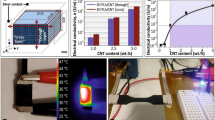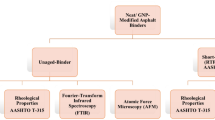Abstract
Thermoplastic and amorphous poly(ethylene terephthalate)/clay nanohybrids have been prepared through solution route. Organically modified NK75 nanoclay has been used as filler in different concentrations to enhance the properties. The Young’s modulus has increased significantly (66%) though there is slight reduction in toughness. Halpin Tsai and Hui-Shia models have been fitted well to explain the nature of stiffness for the prediction of the modulus values. Vicker hardness test has shown considerable improved hardness (16%) in nanohybrids and are nicely predicted using the modified rule of mixture model. The effect of uniaxial stretching on the structural development is explored through small angle X-ray scattering and wide angle XRD. The nanoclay has induced short range ordering upon stretching in nanohybrids as compared to pure PET. Nanoclay has induced high barrier for gas permeation in nanohybrids in comparison to pristine PET. Oxygen transmission rate has also been found to decrease up to 38% for using meager amount of nanoclay. The experimental permeability data has been fitted with different models and has been found suitable for its real applications.

PET nanohybrid has been prepared with organically modified NK75 nanoclay showing much improved mechanical, thermal and gas barrier properties as compared to commercially available nanoclay composites. Theoretical prediction has been made from the experimental results.





Similar content being viewed by others
References
Scaffaro R, Botta L, Ceraulo M, La Mantia FP (2011) Effect of kind and content of organo modified clay on properties of PET nanohybrids. J Appl Polym Sci 122(1):384–392
Gökkurt T, Durmus A, Sariboga V, Öksüzömer MA (2013) Investigation of thermal, rheological, and physical properties of amorphous poly (ethylene terephthalate)/organoclay nanohybrid films. J Appl Polym Sci 129(5):2490–2501
Nguyen QT, Baird DG (2006) Preparation of polymer–clay nanohybrids and their properties. Adv Polym Technol 25(4):270–285
Sarkar M, Dana K, Mukhopadhyay TK, Ghatak S (2011) Studies on the suitability of iron-rich Indian bentonites for synthesis of organoclays by intercalation. T Indian Ceram Soc 70(1):23–28
Kapusetti G, Misra N, Singh V, Srivastava S, Roy P, Dana K, Maiti P (2014) Bone cement based nanohybrid as a super biomaterial for bone healing. J Mater Chem B 2(25):3984–3997
Liu J, Boo WJ, Clearfield A, Sue HJ (2006) Intercalation and exfoliation: a review on morphology of polymer nanohybrids reinforced by inorganic layer structures. Mater Manuf Process 21(2):143–151
Choudalakis G, Gotsis AD (2009) Permeability of polymer/clay nanohybrids: a review. Eur Polym J 45(4):967–984
Thostenson ET, Li C, Chou TW (2005) Nanohybrids in context. Compos Sci Technol 65(3–4):491–516
Nam PH, Maiti P, Okamoto M, Kotaka T, Hasegawa N, Usuki A (2001) A hierarchical structure and properties of intercalated polypropylene/clay nanohybrids. Polymer 42(23):9633–9640
Pandey S, Jana KK, Aswal VK, Rana D, Maiti P (2017) Effect of nanoparticle on the mechanical and gas barrier properties of thermoplastic polyurethane. Appl Clay Sci 146:468–474
Jana KK, Charan C, Shahi VK, Mitra K, Ray B, Rana D, Maiti P (2015) Functionalized poly (vinylidene fluoride) nanohybrid for superior fuel cell membrane. J Membr Sci 481:124–136
Al Jabareen A, Al-Bustami H, Harel H, Marom G (2013) Improving the oxygen barrier properties of polyethylene terephthalate by graphite nanoplatelets. J Appl Polym Sci 128(3):1534–1539
Ghasemi H, Carreau PJ, Kamal MR, Tabatabaei SH (2012) Properties of PET/clay nanohybrid films. Polym Eng Sci 52(2):420–430
Saxena D, Rana D, Gowd EB, Maiti P (2019) Improvement in mechanical and structural properties of poly (ethylene terephthalate) nanohybrid. SN Appl Sci 1(11):1363
Frounchi M, Dourbash A (2009) Oxygen barrier properties of poly (ethylene terephthalate) nanohybrid films. Macromol Mater Eng 294(1):68–74
Vassiliou AA, Chrissafis K, Bikiaris DN (2010) In situ prepared PET nanohybrids: effect of organically modified montmorillonite and fumed silica nanoparticles on PET physical properties and thermal degradation kinetics. ThermochimicaActa 500(1–2):21–29
Lin Y, Tyler R, Sun H, Shi K, Schiraldi DA (2017) Improving oxygen barrier property of biaxially oriented PET/phosphate glass composite films. Polymer 127:236–240
Lee WD, Im SS, Lim HM, Kim KJ (2006) Preparation and properties of layered double hydroxide/poly (ethylene terephthalate) nanohybrids by direct melt compounding. Polymer 47(4):1364–1371
Saxena D, Soundararajan N, Katiyar V, Rana D, Maiti P (2019) Structural, mechanical, and gas barrier properties of poly (ethylene terephthalate) nanohybrid using nanotalc. J Appl Polym Sci 48607
Anand K, Agarwal US, Joseph R (2007) Carbon nanotubes-reinforced PET nanocomposite by melt-compounding. J Appl Polym Sci 104(5):3090–3095
Jin SH, Park YB, Yoon KH (2007) Rheological and mechanical properties of surface modified multi-walled carbon nanotube-filled PET composite. Compos Sci Technol 67(15–16):3434–3441
Ghanbari A, Heuzey MC, Carreau PJ, Ton-That MT (2013) A novel approach to control thermal degradation of PET/organoclay nanocomposites and improve clay exfoliation. Polymer 54(4):1361–1369
Tiwari VK, Prasad AK, Singh V, Jana KK, Misra M, Prasad CD, Maiti P (2013) Nanoparticle and process induced super toughened piezoelectric hybrid materials: the effect of stretching on filled system. Macromolecules 46(14):5595–5603
Nand AV, Ray S, Travas-Sejdic J, Kilmartin PA (2012) Characterization of polyethylene terephthalate/polyaniline blends as potential antioxidant materials. Mater Chem Phys 134(1):443–450
Hu K, Kulkarni DD, Choi I, Tsukruk VV (2014) Graphene-polymer nanocomposites for structural and functional applications. Prog Polym Sci 39(11):1934–1972
Shen Y, Harkin-Jones E, Hornsby P, McNally T, Abu-Zurayk R (2011) The effect of temperature and strain rate on the deformation behaviour, structure development and properties of biaxially stretched PET–clay nanohybrids. Compos Sci Technol 71(5):758–764
Riggleman RA, Toepperwein G, Papakonstantopoulos GJ, Barrat JL, de Pablo JJ (2009) Entanglement network in nanoparticle reinforced polymers. J Chem Phys 130(24):244903
Affdl JC, Kardos JL (1976) The Halpin-Tsai equations: a review. Polym Eng Sci 16(5):344–352
Hui CY, Shia D (1998) Simple formulae for the effective moduli of unidirectional aligned composites. Polym Eng Sci 38(5):774–782
Chen B, Evans JR (2006) Elastic moduli of clay platelets. Scriptamaterialia 54(9):1581–1585
Fan Z, Gong F, Nguyen ST, Duong HM (2015) Advanced multifunctional graphene aerogel–poly (methyl methacrylate) composites: experiments and modeling. Carbon 81:396–404
Goyal RK, Tiwari AN, Negi YS (2008) Microhardness of PEEK/ceramic micro-and nanocomposites: correlation with Halpin–Tsai model. Mater Sci Eng A 491(1–2):230–236
Li S, Auddy K, Barber P, Hansen TJ, Ma J, zurLoye HC, Ploehn HJ (2012) Thermal, mechanical, and barrier properties of polyethylene terephthalate platelet nanocomposites prepared by in situ polymerization. Polym Eng Sci 52(9):1888–1902
Kawakami D, Hsiao BS, Burger C, Ran S, Avila-Orta C, Sics I et al (2005) Deformation-induced phase transition and superstructure formation in poly (ethylene terephthalate). Macromolecules 38(1):91–103
Kawakami D, Ran S, Burger C, Fu B, Sics I, Chu B, Hsiao BS (2003) Mechanism of structural formation by uniaxial deformation in amorphous poly (ethylene terephthalate) above the glass temperature. Macromolecules 36(25):9275–9280
Ran S, Wang Z, Burger C, Chu B, Hsiao BS (2002) Mesophase as the precursor for strain-induced crystallization in amorphous poly(ethylene terephthalate) film. Macromolecules 35(27):10102–10107
Debye P, Bueche AM (1949) Scattering by an inhomogeneous solid. J Appl Phys 20(6):518–525
Mishra A, Aswal VK, Maiti P (2010) Nanostructure to microstructure self-assembly of aliphatic polyurethanes: the effect on mechanical properties. J Phys Chem B 114(16):5292–5300
Imai M, Mori K, Mizukami T, Kaji K, Kanaya T (1992) Structural formation of poly(ethylene terephthalate) during the induction period of crystallization: 2. Kinetic analysis based on the theories of phase separation. Polymer 33(21):4457–4462
Nielsen LE (1967) Models for the permeability of filled polymer systems. J Macromol Sci Chem 1(5):929–942
Bharadwaj RK (2001) Modeling the barrier properties of polymer-layered silicate nanohybrids. Macromolecules 34(26):9189–9192
Acknowledgements
DS acknowledges the institute for her teaching assistantship.
Author information
Authors and Affiliations
Corresponding author
Ethics declarations
Conflict of interest
Authors declare no conflict of interest.
Additional information
Publisher’s note
Springer Nature remains neutral with regard to jurisdictional claims in published maps and institutional affiliations.
Electronic supplementary material
ESM 1
(DOCX 104 kb)
Rights and permissions
About this article
Cite this article
Saxena, D., Jana, K.K., Soundararajan, N. et al. Potency of nanolay on structural, mechanical and gas barrier properties of poly(ethylene terephthalate) Nanohybrid. J Polym Res 27, 35 (2020). https://doi.org/10.1007/s10965-020-2011-2
Received:
Accepted:
Published:
DOI: https://doi.org/10.1007/s10965-020-2011-2




